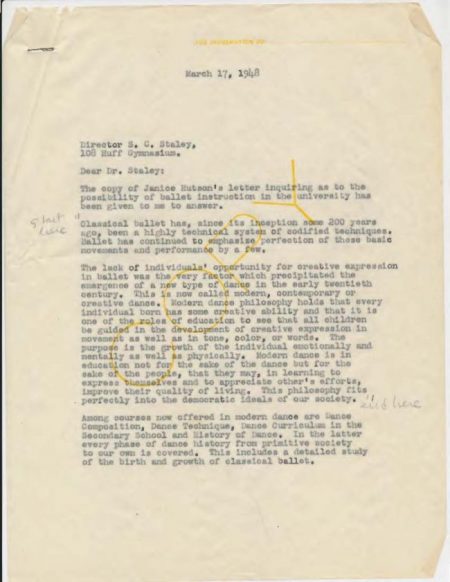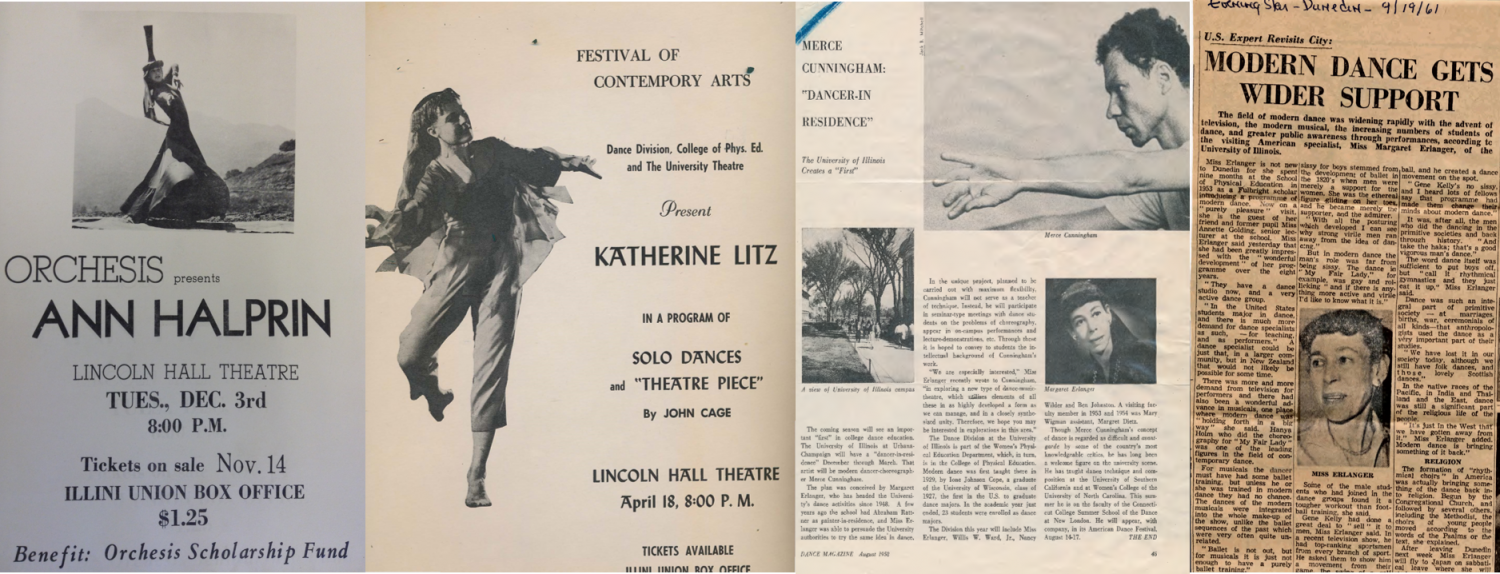The University of Illinois has made many contributions to different fields of knowledge throughout its history; an important aspect of this history is Illinois’ contributions to modern dance.
Although dance performances were taking place at Illinois as early as 1898 through, for example, the May Fête celebrations, the early 20th century saw dance at Illinois evolve from a recreational activity such as the May Fête to high-end artistic and academic education.
By 1920, the Department of Physical Education for Women offered academic credits for two dance classes: “interpretative” and “natural” dance (see the Dance Department’s history page). However, it was Professor Margaret Erlanger whose work lead to the re-interpretation of dance in the University as a form of art and an academic subject, beyond its recreational and athletic dimensions. Erlanger came to Illinois in 1948 to the Department of Physical Ed for Women, and that same year began to work intensively to push forward the creation of a Dance Division that would offer a B.A. in Dance. By then, only ten schools across the country were offering a degree in Dance, as Erlanger notes in a May 2nd 1949 letter to the director of Physical Education (letter linked through the image below, page 4). Erlanger, one of the first graduates from the pioneer program at the University of Wisconsin led by Margaret H’Doubler, addressed University administrators with strong arguments about the emergence of Modern Dance, the importance of implementing an academic program at Illinois, and the increasing demand of dance education in the country.
In 1948, she wrote in a letter to the director of the Physical Education Department:
“…Modern dance philosophy holds that every individual born has some creative ability and that it is one of the roles of education to see that all children be guided in the development of creative expression in movement as well as in tone, color, or words. The purpose is the growth of the individual emotionally and mentally, as well as physically. Modern dance is in education not for the sake of dance, but for the sake of people… This philosophy fits perfectly into the ideals of our society”

Margaret Erlanger Papers
Through intense work in developing proposals for a dance curriculum, gaining support from colleagues, and convincing administrators of the value of the field, in 1949–only one year after Erlanger’s arrival on campus–she created a curriculum for a specialization in dance within the B.S. degree program for Physical Education. From there, the path of academic education in dance at Illinois began, creating a M.A. in 1959 and a B.A. in 1962.
The vibrant environment of the Dance Division drew such dance legends as José Limon and Agnes de Mille, who performed on campus as early as 1953 and 1954 respectively. The Dance Division also invited the internationally influential artist Ann Harplin to direct a piece with the Division’s group Orchesis (1957).
Notably, Illinois became the first school with a Dancer-in-residence permanent position in 1959. The first dancer holding this position was no other than Merce Cunningham. Cunningham taught on campus, created pieces for dance students and for himself, which were showed on campus in a concert at the end of his residency. Cunningham and company returned to Illinois in several occasions to teach and show work, which included several collaborations with contemporary music legend John Cage. A highlight of these collaborations was the 1967 concert for the University festival “Matrix for the Arts,” which was part of the University’s Centennial celebration. For that concert, Cage staged a “Happening” at the Stock Pavilion, at a time when “Happenings” as contemporary art forms had appeared only about ten years before. During the 1950s and 60s several other dance legends visited Illinois as dancers in residence, including Katherine Litz, Paul Taylor, Anna Sokolow, Alwin Nikolais, Steve Paxton and Katharine Dunham.

The opportunity of having professional companies teaching and creating work on campus, made of Dance at Illinois a pioneer in dance education, and made of that Department a unique environment for artistic experimentation. It attracted such world-renown dancers as Beverly Blossom and Joan Skinner, who eventually became dance faculty members. Skinner obtained her Master’s from Illinois (1964) and while teaching at the University, developed the “Skinner release technique” which transformed the modern dance education and put somatic education at the forefront of dance education. This environment made of Illinois a center for the evolution of modern and contemporary dance, as well as the “somatic meca” that it is today as noted Nancy Wozny in 2012 for “Dance Magazine.” Three dancers have received an Honorary Doctorate Degree from the University: Merce Cunningham, Alwin Nikolais, and Katherine Durham.

M. Erlanger Papers (12/13/20), Scrapbook 14.
Through the movement initiated by Professor Erlanger, which was strengthened by the dancers, choreographers, and educators that became part of this process, Dance at Illinois made dance a language of research, innovation, and artistic excellence.
This post is a complement of the exhibit “Dance at Illinois. Milestones and contributions” installed at the Marshall Gallery from the Main Library between May 2nd and through June 30th, 2017. For more information about this topic, you can visit the University Archives, and browse the series: Margaret Erlanger’s papers (Series 12/13/20), Dance Department Records (12/13/1), Dance Programs (RS 12/13/805), and Archives Exhibits File (Series 35/3/54).